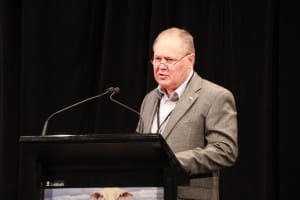Gleaming robotic arms with spinning steel saws slice a lamb carcase into high-value cuts with swift, clinical precision.
Scenes of high-tech, mechanical agility which would not be out of place in the latest Transformers movie featured in a video shown at Australia’s major sheep industry conference Lambex last week.
JBS innovation manager Graham Treffone explained how the company has successfully introduced robotic cutting technology into its processing chain at Bordertown in South Australia.
The innovation has been adopted for a number of reasons, including to improve workplace safety for employees, to increase accuracy and consistency and to maximise the yield of high value cuts, to reduce handling, improve food safety and extend shelf-life and quality, and to increase the overall efficiency of processing.
Mr Treffone explained that in June 2011 a small delegation from JBS Australia was invited to New Zealand by Dunedin-based firm Scott Technologies to discuss the potential adoption of its “Leap lamb cutting” system in JBS’s Australia’s lamb processing operations.
“We were impressed with the technology but we were also wondering how we could develop a payback model based on what we saw,” Mr Treffone said.
In June 2012, after considerable planning, JBS, in partnership with the Australian Meat Processing Corporation and Meat & Livestock Australia, entered into a project to install Scott’s Leap III primal cutting system and a Leap IV middles processing system at its Bordertown abattoir.
Installation on the Leap III primal system began in June 2013 and was commissioned one month later, while installation on the Leap IV system began in December 2013 and was commissioned in February of this year.
This is a simple overview of how the system works, according to Mr Treffone’s description and video footage shown at Lambex last week:
- A lamb carcase is conveyed into an enclosure where an X-Ray camera determines its skeletal characteristics. The image is processed by software which determines the optimal dissection points for that particular carcase and uses that information to then steer the automated cutting towers.
- The carcase is shuttled through to the first robotic cutting tower where the angle of the saws are adjusted to suit the rib structure of the forequarters, which are then removed at the designated point between the fourth and fifth rib.
- The balance of the carcase is then shuttled through to the second tower which grips the barrel and separates it from the leg pair.
- The barrel is transferred to the Middles Processing System (MPS), while the legs are shuttled through to a manual deboning area.
- The middles are loaded into a new position where cameras take images of the eye muscle size and the eye muscle position, which determines the accuracy for the next-stage flap and tail removal cut.
- Additional stages then remove the spinal cord, separate the rack and loin, remove the chime and feather bones from the racks if required and split the racks.
Mr Treffone said the variation in size, weight and breed of Australian lamb carcases had presented the project with a number of challenges which Scott Technologies has had to deal with.
However, the systems are now operating at full capacity at a constant speed of up to 10 carcases per minute, and are providing cutting accuracy, consistent presentation and quality, and a safer environment with less risks to people, Mr Treffone said.
Mr Treffone told the conference that the successful outcome meant the R&D support on the project, the level of which was not disclosed, had been fully justified.
He said the next generation of robotic processing technology would include forequarter processing, shank tipping, leg boning and lean meat yield prediction.
Asked if the technology has led to cuts in the size of its workforce, Mr Treffone said it had moved labour but in reality had not replaced a lot of labour.



Good morning, I was very interested in the report about your move forward into the robotics and how it has increased your turnover. I am looking at attending a trade show. However, trying to find out the dates, times and places is proving difficult. If you have further information I would be very interested in hearing from you.
Kind Regards
Mark Tankard